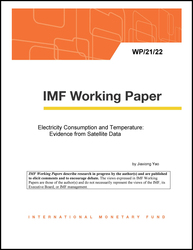
Electricity Consumption and Temperature: Evidence from Satellite Data
Electricity Consumption and Temperature: Evidence from Satellite Data
READ MORE...
Volume/Issue:
Volume 2021
Issue 022
Publication date: February 2021
ISBN: 9781513568539
$18.00
Add to Cart by clicking price of the language and format you'd like to purchase
Available Languages and Formats
| English |
Prices in red indicate formats that are not yet available but are forthcoming.
Topics covered in this book
This title contains information about the following subjects.
Click on a subject if you would like to see other titles with the same subjects.
Economics- Macroeconomics , Environmental Economics , Demography , Electricity consumption , temperature , night light , climate change , , WP , electricity access , electricity demand , term E
Summary
Past studies on the relationship between electricity consumption and temperature have primarily focused on individual countries. Many regions are understudied as a result of data constraint. This paper studies the relationship on a global scale, overcoming the data constraint by using grid-level night light and temperature data. Mostly generated by electricity and recorded by satellites, night light has a strong linear relationship with electricity consumption and is correlated with both its extensive and intensive margins. Using night light as a proxy for electricity consumption at the grid level, we find: (1) there is a U-shaped relationship between electricity consumption and temperature; (2) the critical point of temperature for minimum electricity consumption is around 14.6°C for the world and it is higher in urban and more industrial areas; and (3) the impact of temperature on electricity consumption is persistent. Sub-Saharan African countries, while facing a large electricity deficit already, are particularly vulnerable to climate change: a 1°C increase in temperature is estimated to increase their electricity demand by 6.7% on average.
Copyright © 2010 - 2024
Powered by:
AIDC



